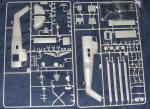
| KIT: | Italeri 1/72 Wessex HAS.3 |
| KIT #: | 1258 |
| PRICE: | $18.50 MSRP |
| DECALS: | Three options |
| REVIEWER: | Scott Van Aken |
| NOTES: |

| HISTORY |
To make a long story short, the Wessex HAS.3 was an improved version of the original HAS.1, itself a development of the Sikorsky model S-58 (or H-34 in US military service). Between 1965 and 1968, fourty-three of these earlier versions were upgraded to the new standard, easily recognized by the dorsal radome for the search radar that gave the HAS.3 its nickname of 'Camel'. Other than this feature, modifications focused mainly on the flight stabilization system and mission equipment, including the more effective Plessey sonar. The weaponry for the ASW mission typically consisted of Mk. 44 or 46 torpedoes or the Mk 11 depth charge. Starting in the mid 1970s, the Wessex HAS.3 was gradually replaced by the Sea King, though the Wessex was around long enough to participate in the Falklands War of the early 1980s.
| THE KIT |
 Italeri has established itself as probably the premier helicopter kit manufacturer, for no other company has such a long list of rotary wing aircraft in its catalogue. As is the norm nowadays, this one can trace much of its parts count to the H-34 Sea Bat kit, providing the newer pieces that are needed for the Wessex HAS.3. Those parts from the previous kit that are not needed are represented by blank areas on the sprues.
Italeri has established itself as probably the premier helicopter kit manufacturer, for no other company has such a long list of rotary wing aircraft in its catalogue. As is the norm nowadays, this one can trace much of its parts count to the H-34 Sea Bat kit, providing the newer pieces that are needed for the Wessex HAS.3. Those parts from the previous kit that are not needed are represented by blank areas on the sprues.
In company with other modern kits, this one has nicely engraved panel lines and a considerable amount of surface detail. The nasties like flash and sink areas are basically non-existent, while ejector pin marks are going to be hidden. Thanks to not putting the sprues in an inner bag, my kit (which wasn't sealed) had several parts depart the sprue and go missing out of the box. Fortunately, I found the important ones (landing gear legs) rattling around in the shipping box.
The kit provides very good cockpit detailing consisting of seats and cyclic controls. The collective will have to be made by the modeler as this rather important control was omitted in the kit's design (a situation that is quite typical of many helicopter kits). The instrument panel has raised detailing on it or you can use a decal. There is a cabin section, but it is void of any detail aside from a floor and fore/aft bulheads. A separate cabin door is provided should you decide to use your skills to populate the cabin. The rotor head is convincing in this scale and the blades are molded with the proper droop. 
There are few options, those mostly consisting of using floatation gear and/or a rescue hoist. I found it quite nice to be able to leave the rotor head and rotors off until the very last construction step. This will greatly facilitate painting without the worry of breaking the rotor shaft.
Instructions are superb and provide both generic and Model Master color references. There are marking options for three aircraft. All are shown either on the cover or back of the box in full color, which is quite helpful. They are: the box art helo from what I have since found out is 737 NAS in yellow and blue, an overall yellow SAR version from the UK in 1967, and a dark sea grey version from the HMS Antrim during the Falklands war in 1982. The decal sheet is very nicely done and looks to be in perfect registration.
| CONCLUSIONS |
It is nice to see this addition to the Wesses/H-34 family. You can probably toss your Matchbox kits or give them to someone else as these Italeri versions are so much better.
April 2006
| REFERENCES |
Thanks to  and DLV Company for the review kit. You can find Italeri kits at your favorite hobby shop or on-line at www.testors.com
and DLV Company for the review kit. You can find Italeri kits at your favorite hobby shop or on-line at www.testors.com
If you would like your product reviewed fairly and fairly quickly by asite that has over 300,000 visitors a month, please contactme or see other details in the